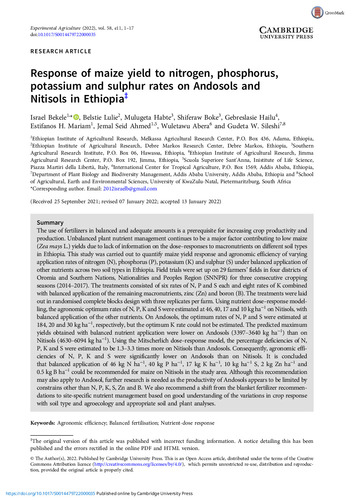Response of maize yield to nitrogen, phosphorus, potassium and sulphur rates on Andosols and Nitisols in Ethiopia
The use of fertilizers in balanced and adequate amounts is a prerequisite for increasing crop productivity and production. Unbalanced plant nutrient management continues to be a major factor contributing to low maize (Zea mays L.) yields due to lack of information on the dose–responses to macronutrients on different soil types in Ethiopia. This study was carried out to quantify maize yield response and agronomic efficiency of varying application rates of nitrogen (N), phosphorus (P), potassium (K) and sulphur (S) under balanced application of other nutrients across two soil types in Ethiopia. Field trials were set up on 29 farmers’ fields in four districts of Oromia and Southern Nations, Nationalities and Peoples Region (SNNPR) for three consecutive cropping seasons (2014–2017). The treatments consisted of six rates of N, P and S each and eight rates of K combined with balanced application of the remaining macronutrients, zinc (Zn) and boron (B). The treatments were laid out in randomised complete blocks design with three replicates per farm. Using nutrient dose–response modelling, the agronomic optimum rates of N, P, K and S were estimated at 46, 40, 17 and 10 kg ha−1 on Nitisols, with balanced application of the other nutrients. On Andosols, the optimum rates of N, P and S were estimated at 184, 20 and 30 kg ha−1, respectively, but the optimum K rate could not be estimated. The predicted maximum yields obtained with balanced nutrient application were lower on Andosols (3397–3640 kg ha−1) than on Nitisols (4630–6094 kg ha−1). Using the Mitscherlich dose–response model, the percentage deficiencies of N, P, K and S were estimated to be 1.3–3.3 times more on Nitisols than Andosols. Consequently, agronomic efficiencies of N, P, K and S were significantly lower on Andosols than on Nitisols. It is concluded that balanced application of 46 kg N ha−1 , 40 kg P ha−1 , 17 kg K ha−1 , 10 kg ha−1 S, 2 kg Zn ha−1 and 0.5 kg B ha−1 could be recommended for maize on Nitisols in the study area. Although this recommendation may also apply to Andosol, further research is needed as the productivity of Andosols appears to be limited by constrains other than N, P, K, S, Zn and B. We also recommend a shift from the blanket fertilizer recommendations to site-specific nutrient management based on good understanding of the variations in crop response with soil type and agroecology and appropriate soil and plant analyses.

